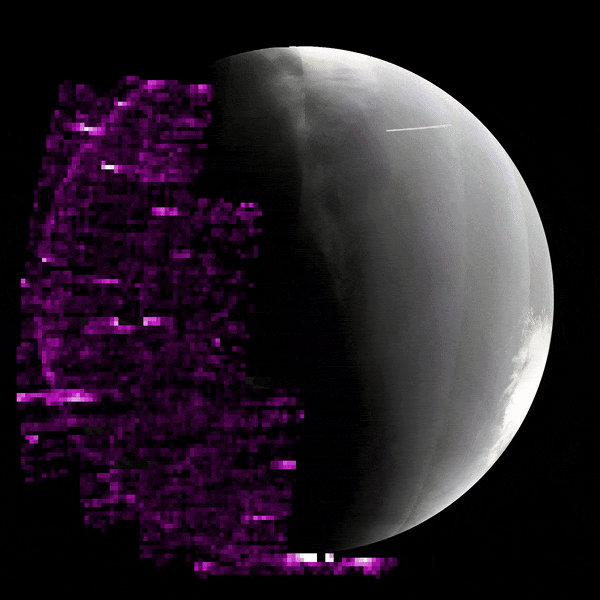Solar System
After Months of Glitches and Gradual Fixes, Voyager 1 Is Fully Operational Once Again
Currently 15 billion miles away from Earth, one of NASA’s longest-tenured spacecraft is back from the brink after a technical failure last year put its future in question
Mars Was Hit With a Solar Storm Days After Earth's Aurora Light Show, NASA Says
Studying this event could hold lessons for scientists about how to protect astronauts from radiation on future trips to the Red Planet
A Giant Interstellar Cloud May Have Once Enveloped Earth, Potentially Causing Ice Ages
Astronomers suggest this cold, dense cloud compressed our sun's protective field between two and three million years ago, leaving the Earth exposed to cosmic material
Astronomers Discover Water Frost on Mars' Tallest Volcanoes
On early winter mornings, a thin layer of ice forms in craters atop the Red Planet's towering peaks, near its equator, according to a new study
Missed the Auroras in May? Here’s How to See Them Next Time
Three veteran aurora chasers and a NASA scientist share everything you need to know to check these dazzling displays off your bucket list
Missed the 'Parade of Planets'? These Upcoming Alignments Will Likely Be Better, Anyway
Astronomers tempered expectations of the celestial event this week, pointing to others in the near future as more exciting opportunities for sky watchers
Venus Might Still Have Active Volcanoes, as Recent Lava Flows Suggest 'Ongoing' Eruptions
Astronomers have again discovered evidence of recent volcanic activity on Earth's sister planet in data from the 1990s
Researchers Trace the Origin of the Sun's Magnetic Field, Shedding Light on Space Weather and Solar Cycles
In a new study, scientists suggest the sun's magnetic field originates much closer to the star's surface than previously thought, a finding that could boost predictions of solar activity
The Seven Most Amazing Discoveries We’ve Made by Exploring Jupiter
The giant planet is a world of extremes
See 12 Breathtaking Images of the Northern Lights, Spotted in Shocking Places Over the Weekend
A period of unusually strong solar activity meant the colorful aurora borealis could be seen much farther south than normal
Scientists Discover 27,500 Asteroids in Old Telescope Images Using A.I.
While most of the team’s new finds are located in the main asteroid belt, about 100 are near-Earth asteroids that pass close to our planet's orbit
How to Watch the Dazzling Eta Aquarid Meteor Shower, Bringing an Unusual 'Outburst' to Skies This Weekend
This year's spectacle will be more impressive than usual, as the Earth passes through a concentrated clump of 3,000-year-old comet debris
The Seven Most Amazing Discoveries We’ve Made by Exploring Mercury
Only two robotic missions have made it to the Swift Planet, but they were crucial for upending many false assumptions of that sun-scorched world
Meteorites Are Becoming Harder to Find as They Sink Into Antarctica's Melting Ice
The disappearing space rocks are burying valuable clues into the history and composition of our solar system, according to a new study
How to Watch the Brilliant Lyrid Meteor Shower This Month
Fiery streaks will illuminate the night sky from April 15-29, with the spectacle's peak occurring from April 21-22
These 15 Photos Show How the 2024 Total Solar Eclipse Captivated the Nation
From Texas to Maine, millions of Americans looked up and were spellbound by the spectacular phenomenon
Why We Love Eclipses
Two perspectives on the astronomical phenomenon that has fascinated humans for as long as we’ve been watching the skies
Titan's Massive Dunes May Be a Comet and Moon Graveyard From the Early Solar System
A new modeling study suggests the dark dunes on Saturn's largest moon are made of tiny particles created by crashing comets and moonlets billions of years ago
Mars Has an Unexpected Influence on Earth's Oceans and Climate, Repeating Every 2.4 Million Years, Study Finds
The gravitational interactions between Mars and Earth as they orbit the sun may have periodically promoted a warmer climate and changes in ocean circulation on our home planet
You Can See a Rare, Bright Comet This Month. Will It Be Visible During the Solar Eclipse?
Comet 12P/Pons-Brooks is a frigid, volcanic ice ball that won’t pass near Earth again until 2095
Page 1 of 14
:focal(4096x2321:4097x2322)/https://tf-cmsv2-smithsonianmag-media.s3.amazonaws.com/filer_public/c1/85/c185108a-791f-4610-9084-98dcb2c0a49a/voyager2.jpg)

:focal(537x445:538x446)/https://tf-cmsv2-smithsonianmag-media.s3.amazonaws.com/filer_public/e8/b6/e8b68174-1c9b-465e-8469-b66151dd09fa/heliosphere.jpg)
:focal(845x459:846x460)/https://tf-cmsv2-smithsonianmag-media.s3.amazonaws.com/filer_public/ef/ff/efffec3e-d663-4701-8116-ec653f5d3ca9/perspective_view_of_frosty_olympus_mons.png)
:focal(360x240:361x241)/https://tf-cmsv2-smithsonianmag-media.s3.amazonaws.com/filer_public/47/ed/47ed2f31-f77b-4c3f-a20a-574bc1a8c214/sinha2_aurorasaurus_pho_20240411.jpg)
:focal(4000x2095:4001x2096)/https://tf-cmsv2-smithsonianmag-media.s3.amazonaws.com/filer_public/03/64/03647ce0-0203-473c-8ba1-c5cc4725de7e/gettyimages-182910299.jpg)
:focal(625x351:626x352)/https://tf-cmsv2-smithsonianmag-media.s3.amazonaws.com/filer_public/d9/43/d9438ca3-e253-40a4-b6eb-142189c2657c/1-jpegpia00108.webp)
:focal(900x844:901x845)/https://tf-cmsv2-smithsonianmag-media.s3.amazonaws.com/filer_public/dc/70/dc707415-ed07-4cb0-a6d6-5445853e8046/gsfc_20171208_archive_e000393orig.jpg)
:focal(800x602:801x603)/https://tf-cmsv2-smithsonianmag-media.s3.amazonaws.com/filer_public/03/9e/039e6fe8-6beb-47e0-8f10-65cd3b2f5781/main_46577295485_94943f56db_o_web.jpg)
:focal(3842x2580:3843x2581)/https://tf-cmsv2-smithsonianmag-media.s3.amazonaws.com/filer_public/57/c0/57c0194a-54ac-4e05-b226-ed838e4a9bbd/gettyimages-2151911419.jpg)
:focal(1920x1097:1921x1098)/https://tf-cmsv2-smithsonianmag-media.s3.amazonaws.com/filer_public/48/ed/48ed9748-7021-489a-a4c9-daf2d57d3cd1/angledview.png)
:focal(512x341:513x342)/https://tf-cmsv2-smithsonianmag-media.s3.amazonaws.com/filer_public/68/38/68389cd5-7ba9-42f1-afb5-937a0bfd18ca/8711805373_c1221fe8a3_b.jpg)
:focal(720x542:721x543)/https://tf-cmsv2-smithsonianmag-media.s3.amazonaws.com/filer_public/11/a8/11a8f779-8331-4682-8899-246f3c2815ba/main_esa_ssiow_iridescent_mercury_web.jpg)
:focal(930x700:931x701)/https://tf-cmsv2-smithsonianmag-media.s3.amazonaws.com/filer_public/2f/af/2faf224c-16ac-4efd-8bb9-e19576c87625/arctic2.jpg)
:focal(4330x2887:4331x2888)/https://tf-cmsv2-smithsonianmag-media.s3.amazonaws.com/filer_public/10/0e/100e6843-676a-4707-b81e-79588851dda4/gettyimages-1220506373.jpg)
:focal(2778x1852:2779x1853)/https://tf-cmsv2-smithsonianmag-media.s3.amazonaws.com/filer_public/48/89/48899e6a-4391-4bee-9676-b60941ea1039/gettyimages-2141953090.jpg)
:focal(700x527:701x528)/https://tf-cmsv2-smithsonianmag-media.s3.amazonaws.com/filer_public/c9/98/c9981180-9665-4e4e-8390-93dcf586d711/smithmag-podcast-s02-ep04-eclipse-article.jpg)
:focal(762x434:763x435)/https://tf-cmsv2-smithsonianmag-media.s3.amazonaws.com/filer_public/77/28/772863a6-f8bc-4b47-ac3e-4ca78a6d115a/titan2.webp)
:focal(681x512:682x513)/https://tf-cmsv2-smithsonianmag-media.s3.amazonaws.com/filer_public/0a/d7/0ad73452-f6d2-47e4-ad5b-d4bc1abae738/ezgif-3-0b922f8a81_cropped.jpg)
:focal(2190x1439:2191x1440)/https://tf-cmsv2-smithsonianmag-media.s3.amazonaws.com/filer_public/ec/e0/ece0719b-6ecc-417d-a3e3-7b1dfea815e1/pons_brooks.jpg)